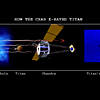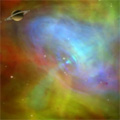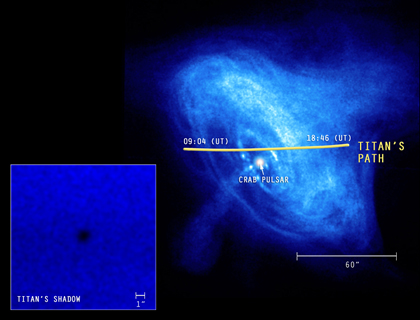Titan Casts Revealing Shadow
On January 5, 2003, Titan — Saturn's largest moon and the only moon in the solar system with a thick atmosphere — crossed in front of the Crab Nebula, a bright, extended X-ray source. Titan's transit enabled Chandra to image the one-arcsecond-diameter X-ray shadow cast by the moon (inset). This tiny shadow corresponds to the size of a dime as viewed from about two and a half miles.
The diameter of Titan's shadow was found to be larger than the known diameter of its solid surface. This difference in diameters yields a measurement of about 550 miles (880 kilometers) for the height of the X-ray absorbing region of Titan's atmosphere.
The extent of the upper atmosphere is consistent with, or slightly (10-15%) larger, than that implied by Voyager I observations made at radio, infrared, and ultraviolet wavelengths in 1980. Saturn was about 5% closer to the Sun in 2003, so increased solar heating of Titan may have caused its atmosphere to expand.
Although Titan passes within a few degrees of the Crab Nebula every 30 years, it rarely passes directly in front of it. This may have been the first transit of the Crab Nebula by Titan since the nebula was formed by a supernova that was observed to occur in the year 1054. The next similar conjunction will take place in the year 2267, so this was truly a once in a millennium event.
|
||||||||||||||||||||||||||||
Two images are shown in this feature - one is an X-ray image of the Crab Nebula (right) and the other is an X-ray image of the shadow of the moon Titan (left inset). The Crab X-ray image appears bright blue and white in a bell shape on a black background, while the image of Titan is a small, black fuzzy dot on a textured or speckled blue background. On January 5, 2003, Titan — Saturn's largest moon and the only moon in the solar system with a thick atmosphere — crossed in front of the Crab Nebula, a bright, extended X-ray source. Titan's transit enabled Chandra to image the one-arcsecond-diameter X-ray shadow cast by the moon (inset). This tiny shadow corresponds to the size of a dime as viewed from about two and a half miles. The diameter of Titan's shadow was found to be larger than the known diameter of its solid surface. This difference in diameters yields a measurement of about 550 miles (880 kilometers) for the height of the X-ray absorbing region of Titan's atmosphere.






